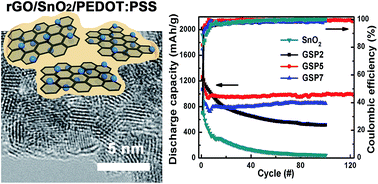Incorporation of PEDOT:PSS into SnO2/reduced graphene oxide nanocomposite anodes for lithium-ion batteries to achieve ultra-high capacity and cyclic stability†
Abstract
SnO2, a candidate material for anodes in Li-ion batteries (LIBs), usually suffers from severe volume change (>300%) during charge–discharge cycles. This problem leads to undesirable continuous capacity fading, hindering its practical utilization. To address this issue, nanostructured SnO2 and its composites with carbon nanomaterials, especially graphene, have extensively been studied. Although the stability issue has improved substantially, these materials still suffer from low capacity characteristics, which are far from the theoretical capacity of SnO2. Motivated by this background, in this work, we synthesized a novel ternary nanocomposite of SnO2, reduced graphene oxide (rGO), and a conducting polymer, poly(3,4-ethylenedioxythiophene)-poly(styrenesulfonate) (PEDOT:PSS), as a high performance anode material in LIBs. PEDOT:PSS together with rGO is expected to efficiently accommodate the volume change in SnO2 during cycling. Transmission electron microscopic observation reveals 2–3 nm-sized SnO2 nanoparticles are uniformly dispersed over rGO nanosheets while having a PEDOT:PSS coating. The capacities of the synthesized composites were dependent on the PEDOT:PSS concentration. The reversible capacity of the composite with 5 wt% PEDOT:PSS was maintained at 980 mA h g−1 with a coulombic efficiency over 99% even after 160 cycles. This capacity value is equivalent to 1185 mA h g−1 on the basis of only SnO2 in the composite. The high capacity of the ternary nanocomposites is attributed to the ultra-small size of SnO2 nanoparticles, enhanced electronic and ionic mobility, and facilitated volumetric relaxation synergistically offered by rGO nanosheets and the PEDOT:PSS coating.

- This article is part of the themed collection: Polymers for Electrochemical Energy Storage

 Please wait while we load your content...
Please wait while we load your content...